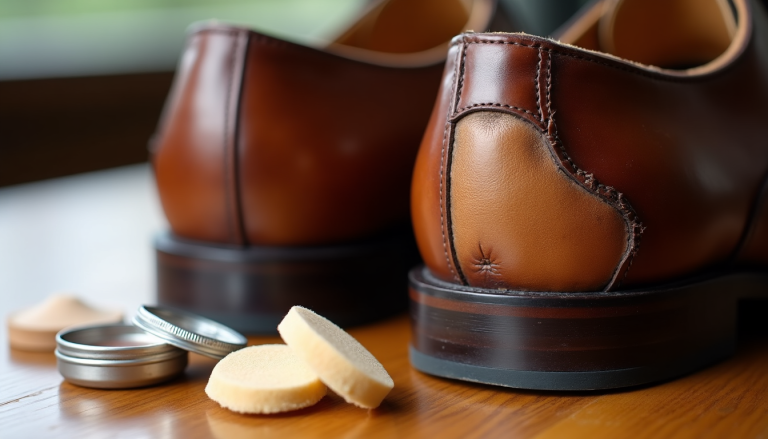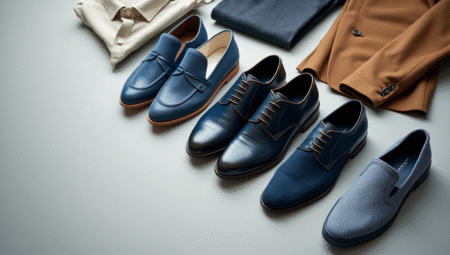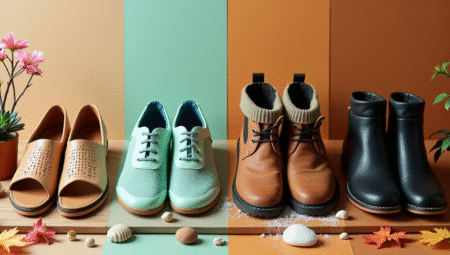Unexpected wear on the heel area of our sneakers and tearing at the back of the shoe is a common issue many of us experience. Especially, the lining on the inner back of the shoe gets worn down due to friction, which shortens the shoe’s lifespan and seriously affects comfort.
If you’re thinking “The back of my shoes are tearing,” there can be several causes. Choosing the wrong size, putting on or taking off shoes incorrectly, and even wearing the wrong socks can lead to this issue. Therefore, we need to adopt proper usage habits and learn the right maintenance techniques to protect our shoes.
In this guide, we will thoroughly explore why the heel area of your shoes gets torn, how to prevent this issue, and how to repair existing damage. We’ll also share practical solutions like gel inserts and protective heel pads.
Causes of Heel Tearing in Shoes
The tearing of the back part of our shoes usually stems from several basic reasons. Understanding these causes is essential to extending the life of our footwear.
Wrong Shoe Size
The most critical point in shoe selection is to pay attention to the bone structure and joint width of our feet. Narrow or small-sized shoes cause constant friction, resulting in quick deformation. Especially if the front and side parts of the shoe are narrow, it prevents toes from moving comfortably.
When choosing a quality shoe, models made of leather both inside and out should be preferred. These types of shoes are breathable and adapt more easily to the shape of the foot. Moreover, having a sufficiently wide sole is especially important for those with balance issues.
Habits When Putting On and Taking Off Shoes
Putting on and taking off shoes properly is an essential part of shoe care. Trying to wear shoes forcefully without loosening the laces causes the heel part to deform quickly. Instead:
– Loosen the laces completely before wearing the shoes
– Use a shoehorn to protect the heel area
– Avoid stepping on one shoe’s heel with the other foot while taking them off
Posture and Gait Disorders
Posture and gait disorders can lead to wear in specific areas of shoes. Particularly in people who sit at a desk for long hours, posture issues may cause uneven wear on shoes. This can result in not only physical but also psychological effects.
Individuals with foot problems such as flat feet experience more wear in the heel section of the shoe. Since body balance starts with the feet, shoes that fail to provide proper support and stability can cause joint problems and unnatural walking.
To prevent gait disorders, choosing sturdy and foot-appropriate shoes is important. Additionally, using protective materials during sports activities and maintaining shoes regularly can also extend their lifespan.
Heel Tearing in Different Types of Shoes
Depending on the usage purpose and design of different types of shoes, we encounter various tearing problems. Each shoe type has its own sensitive areas.
Heel Wear in Sports Shoes
The most common issue in sports shoes is the early deformation of the heel lining. Continuous friction from the Achilles tendons can wear out the padding quickly. If the shoe size is not appropriate, the heels constantly press into the back of the shoe, causing both lining tension and painful blisters.
Cotton socks can also trigger this problem. Cotton holds moisture and increases friction by getting trapped between the heel and the shoe. Instead, merino wool running socks or socks with extra heel padding should be preferred.
Tearing in Everyday Shoes
Even with standard use, everyday shoes may experience various tearing issues. Common problems include toe cap separation, cracking in nubuck leather, and openings where the upper connects with the sole. Cracked paint on the sole strips and solution-based separation of the outsole are also frequently seen.
In leather shoes, cracks often occur in areas that are constantly bent or stretched. This negatively impacts both appearance and comfort. Extreme hot or cold weather also dries out the leather and speeds up the formation of cracks.
Lining Issues in Formal Shoes
Lining tearing in formal shoes typically stems from two primary reasons. First is wearing the shoes without a shoehorn. Friction generated with each wear quickly erodes the surface. Second is putting on the shoes by crushing the back. This not only damages the rigid part but also the fabric lining.
In addition, excessive foot sweating causes lining issues. The moisture, vapor, heat, and bacteria released from sweat can cause both odor and deformation if there’s not enough ventilation. Thus, it’s important to follow the rule of alternating shoes every other day.
How to Prevent Heel Tearing in Shoes
Taking preventative measures to protect the back part of your shoes helps save both your budget and your foot health in the long run. Applying some fundamental methods is essential.
Choosing the Right Shoes
The most important point when selecting shoes is choosing models that match your foot length and width. When trying on shoes, there should be a 1–1.5 cm gap between your longest toe and the front of the shoe. Also, it’s crucial to measure both feet separately, as most people have a half-size difference between their feet.
New shoes may be stiff at first and can irritate your heels. However, if the size is correct, they should adapt to your feet over time. If your heels constantly press into the back of the shoe, the size is likely too small.
Heel Protector Products
Heel protectors offer effective solutions to protect the back of your shoes. Especially, silicone heel protectors are among the most popular due to their soft and flexible structure. These products are placed inside the shoe to provide maximum comfort and prevent sweating.
Additionally, gel linings are also an effective option. These are washable and reusable, made from cool gel infused with mineral oil. Foldable inserts made from ballistic fabric can also prevent your heels from crushing the back of the shoe.
Establishing a Shoe Care Routine
Regular maintenance is the most effective way to extend the life of your shoes. Brands like Skechers recommend the every-other-day wear rule—after wearing shoes, air them out for a day before using them again.
To reduce moisture in the shoe lining, avoid wearing shoes without socks. It’s also important to fully loosen the laces when putting on or taking off shoes. You can use your thumb as a buffer for your heel to help your foot slide in and out easily.
Stepping on or folding the stiff counter part of the shoe can cause irreversible damage. Therefore, always use a shoehorn when putting on or taking off your shoes. If improper use is repeated over time, the heel counter will become largely deformed.
Techniques to Salvage Torn Shoes
Before discarding torn or damaged shoes, you can try various repair methods. With the right techniques and materials, many shoe problems can be resolved.
DIY Repair Methods at Home
You can fix minor tears and peeling at home. First, use a clean cloth or brush to remove dust from the shoes. Then, trim any peeling or raised leather with scissors to create a smooth surface. Apply leather glue to the affected area and press the part into place to secure it.
To correct color differences, you can use special color-matching markers. Once the process is complete, protect the surface with leather protector sprays to prevent future peeling. Also, use specially formulated oils for leather shoes to maintain their flexibility.
When to Visit a Professional Cobbler
In some cases, professional help is unavoidable. Especially for complex and delicate cleaning tasks or when structural components of the shoe need to be replaced, expert support is important. These include:
– Heel repair
– Sole replacement
– Lining replacement
– Shoes made of special materials or decorative designs
– Repairs for orthopedic shoes
Suggestions for Unrepairable Shoes
If your shoes are beyond repair, consider eco-friendly solutions. Some brands, like Nike, offer recycling programs in participating stores. This way, your shoes can be used as raw materials for new products.
Regular maintenance is essential to prolong the life of your shoes. Store your shoes in a cool, dry place and protect them from sunlight and moisture. Also, by wearing shoes every other day, you allow them to air out and prevent deformation.
To prevent cracks in leather shoes, you can use natural products like olive oil and beeswax. These materials moisturize the leather and reduce the appearance of cracks. For suede and nubuck shoes, special brushes and sprays should be used.
Heel tearing at the back of our shoes is a preventable problem. With proper sizing, appropriate usage habits, and regular maintenance, we can significantly extend the life of our footwear. Using preventative products like heel protectors and quality socks largely eliminates this issue.
Don’t give up as soon as your shoes start tearing. Many problems can be solved at home with simple repair techniques, and for more serious issues, seek expert help. Therefore, it’s important to be mindful at every stage from selection to maintenance.
Also, using your shoes every other day and storing them properly will protect both your budget and your foot health in the long term. A good shoe investment and regular care routine are the most effective ways to prevent bothersome heel tears.




